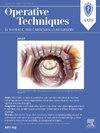Aortic Annular Enlargement with Y-Incision/Rectangular Patch: Tips and Pitfalls
Q3 Medicine
Operative Techniques in Thoracic and Cardiovascular Surgery
Pub Date : 2025-06-01
DOI:10.1053/j.optechstcvs.2024.07.005
引用次数: 0
Abstract
The Y-incision/rectangular patch aortic annular enlargement (Y-incision AAE) was developed in August 2020 as a simple, reproducible, and effective approach for annular enlargement. The goal of the Y-incision AAE is to enlarge the crown-shaped surgical aortic annulus and root to accommodate a larger valve with an orifice that matches the diameter of the patient's basal ring. A complete or partial transverse aortotomy is performed 2.0 cm above the sinotubular junction anteriorly. A Y-incision is made through the left-non commissure onto the aortomitral curtain, extending underneath the crown-shaped surgical aortic annulus into the left and right fibrous trigones. A rectangular patch is sewn to the aortomitral curtain from trigone to trigone, and aortic annulus on both sides. A valve sizer touches all 3 nadirs of the aortic annulus to size the prosthesis. Nonpledgetted 2-0 Ethibond valve sutures are placed in a noneverting fashion. The valve sutures are divided by 3 and distributed evenly to each cusp of the sewing ring after aligning 1 valve strut at the left-right commissure. After the prosthesis is tied down, A 2-3 cm longitudinal aortotomy is performed in the posterior side of the proximal ascending aorta. The patch is trimmed to a triangular shape at distal end and incorporated into the longitudinal aortotomy for the aortic closure while enlarging the sinotubular junction and proximal ascending aorta. The simple and reproducible Y-incision AAE technique upsizes 3-4 valve sizes to achieve optimal hemodynamics and durability while also preparing patients for the next intervention in the lifetime management of aortic valve disease.
用y形切口/矩形补片扩大主动脉环:提示和缺陷
y切口/矩形补片主动脉环扩大术(y切口AAE)于2020年8月被开发出来,是一种简单、可重复、有效的主动脉环扩大方法。y切口AAE的目的是扩大冠状手术主动脉环和根部,以容纳一个更大的瓣膜,该瓣膜带有与患者基环直径相匹配的孔。在窦管连接处前方2.0 cm处行完全或部分横断主动脉。通过左侧非接合处在主动脉二尖瓣幕上做一个y形切口,在冠状手术主动脉环下延伸至左右纤维三角区。从三角区到三角区,在主动脉二尖瓣幕布和两侧的主动脉环上缝合一个长方形的补片。瓣膜尺寸测量仪触摸主动脉环的所有3个底部来确定假体的尺寸。无质押2-0瓣膜缝合线采用无质押方式。在左右接合处对齐1个瓣膜支柱后,将瓣膜缝线分成3个,均匀分布到缝合环的每个尖端。固定假体后,在近端升主动脉后侧行纵2- 3cm主动脉切开术。在远端将补片修剪成三角形,并纳入纵向主动脉切开术,用于主动脉关闭,同时扩大窦小管交界处和近端升主动脉。简单且可重复的y切口AAE技术可扩大3-4个瓣膜大小,以达到最佳的血流动力学和耐久性,同时也为患者在主动脉瓣疾病的终身管理中进行下一次干预做好准备。
本文章由计算机程序翻译,如有差异,请以英文原文为准。
求助全文
约1分钟内获得全文
求助全文
来源期刊

Operative Techniques in Thoracic and Cardiovascular Surgery
Medicine-Surgery
CiteScore
1.40
自引率
0.00%
发文量
59
期刊介绍:
Operative Techniques in Thoracic and Cardiovascular Surgery provides richly illustrated articles on techniques in thoracic and cardiovascular surgery written by renowned surgeons. Each issue presents cardiothoracic topics in adult cardiac, congenital, and general thoracic surgery. Each specialty of interest to the thoracic and cardiovascular surgeon is explored through two different approaches to a specific surgical challenge. Each article is thoroughly illustrated with original line drawings, actual intraoperative photos, and supporting tables and graphs.
 求助内容:
求助内容: 应助结果提醒方式:
应助结果提醒方式:


